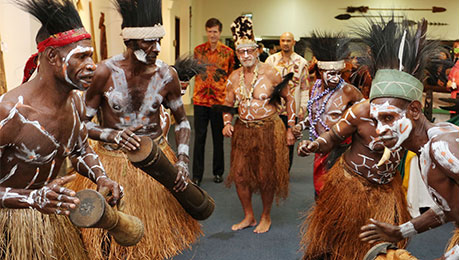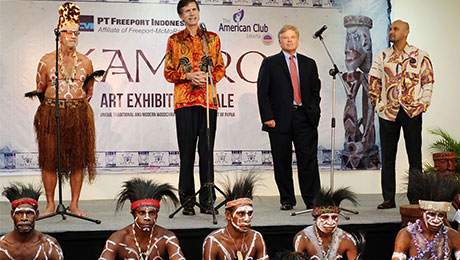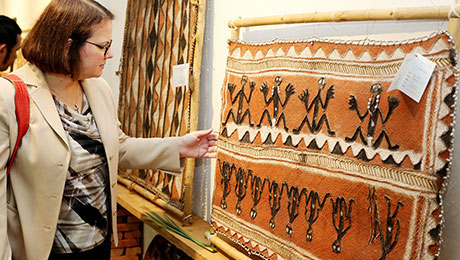30 November 2015

The rain drenching Jakarta all day had finally subsided. It was as if the heavens knew that clement weather was needed for the cultural event that was to take place. A group of Papuans wearing traditional costume filled the room, along with iconic, earth-toned Papuan works of art, ranging from sculptures and paintings, adorning all corners. That night, the American Club theater’s ambiance had the distinctive feel of a Papuan village.
On that Thursday (11/19) night, a Kamoro Arts Exhibition & Sale was held at the American Club situated in the Dharmawangsa area in South Jakarta. The event is an annual activity by Freeport Indonesia in conjunction with the US Embassy, the goal being to introduce Kamooro arts to the outside world, and in particular to international communities. The activity is part of the Company’s commitment to preserve and promote the culture of the Kamoro tribe, through Bersama Untuk Indonesia – Beragam, or Together for a Diverse Indonesia.
The Kamoro works of art displayed included carvings that are specific to this Mimika south coast tribe. Briefly, the Kamoro are skilful carvers who have passed this talent down from generation to generation. The types and motifs of the carvings are heavily influenced by the tribe’s surrounding environment, and myths told and retold by weaiku, the customary elders. Each carving type has a different function: the Mbitoro is sacred to karapao dwellings; Wemawe personify ancestors; the design on the Yamate or shield has a specific significance; and so on.

The host was US Ambassador to Indonesia, His Excellency Robert Blake, who opened the event together with Bill Rigel on behalf of Freeport Indonesia management. Robert Blake conveyed his thanks to Freeport Indonesia for its contribution to the conservation of Kamoro arts and culture, and its efforts to bring the artisans and their works to Jakarta.
The event was not attended by expatriates and government officials alone. Many Indonesian public figures, including designers, artists, and academics were among the guests. The choice of invitees was not random: the organizers had deliberately selected individuals who would be able and most likely to promote Kamoro culture more widely through their respective networks.

Throughout the evening, the guests were immersed in inspecting the works of art and selecting which to purchase as an addition to their personal collection. This was interspersed with cassowary dance performances by the Kamoro, among the mingling guests.
That night, almost 90 percent of the works on display were taken. Proceeds from the sale will go to the respective artisans, providing them with capital to expand their enterprise, and further empowering the economy of the Kamoro community. Nimao! (Trian)
Kami menghimbau para pencari kerja untuk berhati-hati dan mewaspadai beragam modus penipuan perekrutan yang mengatasnamakan PT Freeport Indonesia. Dalam setiap proses rekrutmen dan penerimaan karyawan, PT Freeport Indonesia maupun konsultan rekruitmennya tidak memungut biaya apapun.
Untuk melihat lowongan, silakan akses melalui link berikut: ptfi e-recruitment
Untuk melihat informasi magang, silakan akses melalui link berikut: Internship Program
